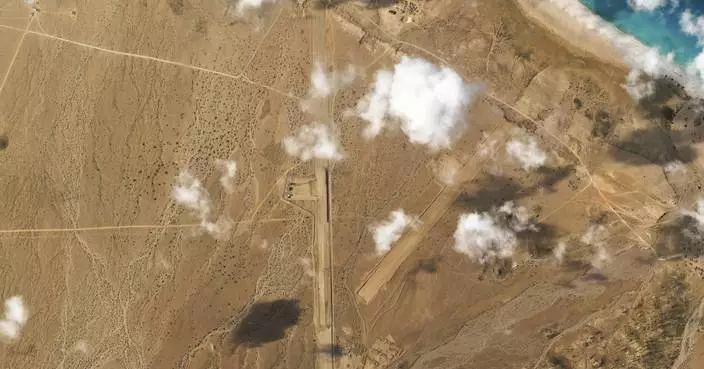The new head of Yemen’s internationally recognized government said on Friday that the council he was chosen to lead will work to end the country’s grinding, eight-year civil war.
In his first televised address, Rashad al-Alimi thanked his government’s backers —Saudi Arabia and the United Arab Emirates — which have been helping Yemeni government forces fight the Iran-backed Houthi rebels for years.
Al-Alimi’s speech comes as both sides trade accusations of breaking the week-old internationally brokered cease-fire that was ushered in at the start of the Islamic holy month of Ramadan. The truce is supposed to last two months but many similar efforts in Yemen's conflict have floundered in the past.
On Thursday, Yemen’s exiled president Abed Rabbo Mansour Hadi stepped aside in a move likely orchestrated in Riyadh, and transferred his powers to the presidential council lead by al-Alimi.
“This is a council of peace, but it is also a council of defense and strength,” he said.
The country’s new head of government made no mention of any compromise with the Houthis. He thanked the U.N. and U.S. envoys to Yemen for their efforts but also praised all who attempted to “take back the country and its institutions."
On Friday, both sides said they had documented some 80 violations of the cease-fire in just the past day, in reports published on their official media. The United Nations’ envoy to Yemen Hans Grundberg on Wednesday expressed concerns about reports of violations of the truce.
Yemen’s brutal civil war erupted in 2014, when the Houthis seized the capital of Sanaa and forced the government into exile. A Saudi-led coalition, including the United Arab Emirates, entered the war in early 2015 to try restore the government to power.
The conflict has in recent years become a regional proxy war that has killed more than 150,000 people, including over 14.500 civilians. It has also created one of the worst humanitarian crises in the world.
In his speech, al-Alimi expressly thanked the country’s armed forces, police and local militias for resisting the rebels. He referred to the Houthis as an “Iranian-project."
Houthi media claimed most of the cease-fire violations over the past 24 hours were in the key rebel-held port city of Hodeida.
The Yemeni government said it had recorded violations on several fronts around the country, including the city of Marib, which the Houthis have been trying to capture for over a year.
That coffee you slurped this morning? It’s 600,000 years old.
Using genes from coffee plants around the world, researchers built a family tree for the world's most popular type of coffee, known to scientists as Coffea arabica and to coffee lovers simply as “arabica.”
The researchers, hoping to learn more about the plants to better protect them from pests and climate change, found that the species emerged around 600,000 years ago through natural crossbreeding of two other coffee species.
“In other words, prior to any intervention from man,” said Victor Albert, a biologist at the University at Buffalo who co-led the study.
These wild coffee plants originated in Ethiopia but are thought to have been first roasted and brewed primarily in Yemen starting in the 1400s. In the 1600s, Indian monk Baba Budan is fabled to have smuggled seven raw coffee beans back to his homeland from Yemen, laying the foundation for coffee’s global takeover.
Arabica coffee, prized for its smooth and relatively sweet flavor, now makes up 60% - 70% of the global coffee market and is brewed by brands such as Starbucks, Tim Horton's and Dunkin'. The rest is robusta, a stronger and more bitter coffee made from one of arabica's parents, Coffea canephora.
To piece together arabica coffee’s past, researchers studied genomes of C. canephora, another parent called Coffea eugenioides, and more than 30 different arabica plants, including a sample from the 1700s — courtesy of the Natural History Museum in London — that Swedish naturalist Carl Linnaeus used to name the plant.
The study was published Monday in the journal Nature Genetics. Researchers from Nestlé, which owns several coffee brands, contributed to the study.
The arabica plant’s population fluctuated over thousands of years before humans began cultivating it, flourishing during warm, wet periods and suffering through dry ones. These lean times created so-called population bottlenecks, when only a small number of genetically similar plants survived.
Today, that renders arabica coffee plants more vulnerable to diseases like coffee leaf rust, which cause billions of dollars in losses every year. The researchers explored the makeup of one arabica variety that is resistant to coffee leaf rust, highlighting sections of its genetic code that could help protect the plant.
The study clarifies how arabica came to be and spotlights clues that could help safeguard the crop, said Fabian Echeverria, an adviser for the Center for Coffee Research and Education at Texas A&M University who was not involved with the research.
Exploring arabica’s past and present could yield insight into keeping coffee plants healthy – and coffee cups full – for future early mornings.
The Associated Press Health and Science Department receives support from the Howard Hughes Medical Institute’s Science and Educational Media Group. The AP is solely responsible for all content.

FILE - Mohammed Fita picks coffee beans on his farm Choche, near Jimma, 375 kilometers (234 miles) southwest of Addis Ababa, Ethiopia, on Saturday, Sept. 21 2002. Wild coffee plants originated in Ethiopia but are thought to have been primarily roasted and brewed in Yemen starting in the 1400s. (AP Photo/Sayyid Azim, File)

FILE - Arabica coffee beans harvested the previous year are stored at a coffee plantation in Ciudad Vieja, Guatemala, on May 22, 2014. In a study published in the journal Nature Genetics on Monday, April 15, 2024, researchers estimate that Coffea arabica came to be from natural crossbreeding of two other coffee species over 600,000 years ago. (AP Photo/Moises Castillo, File)





